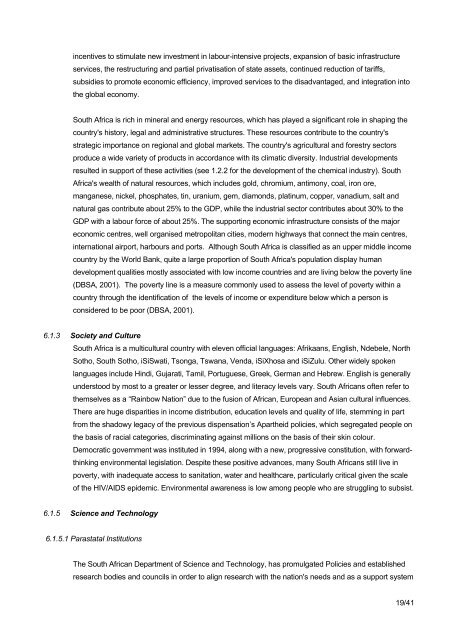E-WASTE ASSESSMENT IN SOUTH AFRICA - e-Waste. This guide
E-WASTE ASSESSMENT IN SOUTH AFRICA - e-Waste. This guide
E-WASTE ASSESSMENT IN SOUTH AFRICA - e-Waste. This guide
Create successful ePaper yourself
Turn your PDF publications into a flip-book with our unique Google optimized e-Paper software.
incentives to stimulate new investment in labour-intensive projects, expansion of basic infrastructureservices, the restructuring and partial privatisation of state assets, continued reduction of tariffs,subsidies to promote economic efficiency, improved services to the disadvantaged, and integration intothe global economy.South Africa is rich in mineral and energy resources, which has played a significant role in shaping thecountry's history, legal and administrative structures. These resources contribute to the country'sstrategic importance on regional and global markets. The country's agricultural and forestry sectorsproduce a wide variety of products in accordance with its climatic diversity. Industrial developmentsresulted in support of these activities (see 1.2.2 for the development of the chemical industry). SouthAfrica's wealth of natural resources, which includes gold, chromium, antimony, coal, iron ore,manganese, nickel, phosphates, tin, uranium, gem, diamonds, platinum, copper, vanadium, salt andnatural gas contribute about 25% to the GDP, while the industrial sector contributes about 30% to theGDP with a labour force of about 25%. The supporting economic infrastructure consists of the majoreconomic centres, well organised metropolitan cities, modern highways that connect the main centres,international airport, harbours and ports. Although South Africa is classified as an upper middle incomecountry by the World Bank, quite a large proportion of South Africa's population display humandevelopment qualities mostly associated with low income countries and are living below the poverty line(DBSA, 2001). The poverty line is a measure commonly used to assess the level of poverty within acountry through the identification of the levels of income or expenditure below which a person isconsidered to be poor (DBSA, 2001).6.1.3 Society and CultureSouth Africa is a multicultural country with eleven official languages: Afrikaans, English, Ndebele, NorthSotho, South Sotho, iSiSwati, Tsonga, Tswana, Venda, iSiXhosa and iSiZulu. Other widely spokenlanguages include Hindi, Gujarati, Tamil, Portuguese, Greek, German and Hebrew. English is generallyunderstood by most to a greater or lesser degree, and literacy levels vary. South Africans often refer tothemselves as a “Rainbow Nation” due to the fusion of African, European and Asian cultural influences.There are huge disparities in income distribution, education levels and quality of life, stemming in partfrom the shadowy legacy of the previous dispensation’s Apartheid policies, which segregated people onthe basis of racial categories, discriminating against millions on the basis of their skin colour.Democratic government was instituted in 1994, along with a new, progressive constitution, with forwardthinkingenvironmental legislation. Despite these positive advances, many South Africans still live inpoverty, with inadequate access to sanitation, water and healthcare, particularly critical given the scaleof the HIV/AIDS epidemic. Environmental awareness is low among people who are struggling to subsist.6.1.5 Science and Technology6.1.5.1 Parastatal InstitutionsThe South African Department of Science and Technology, has promulgated Policies and establishedresearch bodies and councils in order to align research with the nation's needs and as a support system19/41
















